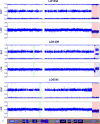Assessment of large copy number variants in patients with apparently isolated congenital left-sided cardiac lesions reveals clinically relevant genomic events
- PMID: 28653806
- PMCID: PMC5560080
- DOI: 10.1002/ajmg.a.38309
Assessment of large copy number variants in patients with apparently isolated congenital left-sided cardiac lesions reveals clinically relevant genomic events
Abstract
Congenital left-sided cardiac lesions (LSLs) are a significant contributor to the mortality and morbidity of congenital heart disease (CHD). Structural copy number variants (CNVs) have been implicated in LSL without extra-cardiac features; however, non-penetrance and variable expressivity have created uncertainty over the use of CNV analyses in such patients. High-density SNP microarray genotyping data were used to infer large, likely-pathogenic, autosomal CNVs in a cohort of 1,139 probands with LSL and their families. CNVs were molecularly confirmed and the medical records of individual carriers reviewed. The gene content of novel CNVs was then compared with public CNV data from CHD patients. Large CNVs (>1 MB) were observed in 33 probands (∼3%). Six of these were de novo and 14 were not observed in the only available parent sample. Associated cardiac phenotypes spanned a broad spectrum without clear predilection. Candidate CNVs were largely non-recurrent, associated with heterozygous loss of copy number, and overlapped known CHD genomic regions. Novel CNV regions were enriched for cardiac development genes, including seven that have not been previously associated with human CHD. CNV analysis can be a clinically useful and molecularly informative tool in LSLs without obvious extra-cardiac defects, and may identify a clinically relevant genomic disorder in a small but important proportion of these individuals.
Keywords: aortic stenosis; chromosome; coarctation aorta; congenital heart disease; genetic; hypoplastic left heart syndrome.
© 2017 Wiley Periodicals, Inc.
Conflict of interest statement
J.W.B. is a fulltime employee of Illumina Inc., but all work was performed under the listed affiliation. The remaining authors have no conflicts of interest to declare.
Figures



Similar articles
-
The contribution of de novo and rare inherited copy number changes to congenital heart disease in an unselected sample of children with conotruncal defects or hypoplastic left heart disease.Hum Genet. 2014 Jan;133(1):11-27. doi: 10.1007/s00439-013-1353-9. Epub 2013 Aug 25. Hum Genet. 2014. PMID: 23979609 Free PMC article.
-
Rare copy number variants contribute to congenital left-sided heart disease.PLoS Genet. 2012 Sep;8(9):e1002903. doi: 10.1371/journal.pgen.1002903. Epub 2012 Sep 6. PLoS Genet. 2012. PMID: 22969434 Free PMC article.
-
Analysis of chromosomal structural variation in patients with congenital left-sided cardiac lesions.Birth Defects Res A Clin Mol Teratol. 2014 Dec;100(12):951-64. doi: 10.1002/bdra.23279. Epub 2014 Jul 26. Birth Defects Res A Clin Mol Teratol. 2014. PMID: 25066379
-
Copy-number variation in congenital heart disease.Curr Opin Genet Dev. 2022 Dec;77:101986. doi: 10.1016/j.gde.2022.101986. Epub 2022 Oct 3. Curr Opin Genet Dev. 2022. PMID: 36202051 Review.
-
Genetics of congenital heart disease: the glass half empty.Circ Res. 2013 Feb 15;112(4):707-20. doi: 10.1161/CIRCRESAHA.112.300853. Circ Res. 2013. PMID: 23410880 Free PMC article. Review.
Cited by
-
Genetic impact of copy number variations on congenital heart defects: Current insights and future directions.Glob Med Genet. 2024 Nov 22;12(1):100008. doi: 10.1016/j.gmg.2024.100008. eCollection 2025 Mar. Glob Med Genet. 2024. PMID: 39925442 Free PMC article. Review.
-
The Role of Genetics in the Management of Heart Failure Patients.Int J Mol Sci. 2023 Oct 16;24(20):15221. doi: 10.3390/ijms242015221. Int J Mol Sci. 2023. PMID: 37894902 Free PMC article. Review.
-
Perspective: DNA Copy Number Variations in Cardiovascular Diseases.Epigenet Insights. 2018 Dec 12;11:2516865718818839. doi: 10.1177/2516865718818839. eCollection 2018. Epigenet Insights. 2018. PMID: 30560231 Free PMC article. Review.
-
Whole exome sequencing in 342 congenital cardiac left sided lesion cases reveals extensive genetic heterogeneity and complex inheritance patterns.Genome Med. 2017 Oct 31;9(1):95. doi: 10.1186/s13073-017-0482-5. Genome Med. 2017. PMID: 29089047 Free PMC article.
-
Modifying Mendel Redux: Unbiased Approaches Can Find Modifiers.Circ Cardiovasc Genet. 2017 Oct;10(5):e001891. doi: 10.1161/CIRCGENETICS.117.001891. Circ Cardiovasc Genet. 2017. PMID: 29025762 Free PMC article. No abstract available.
References
-
- Bachman KK, DeWard SJ, Chrysostomou C, Munoz R, Madan-Khetarpal S. Array CGH as a first-tier test for neonates with congenital heart disease. Cardiol Young. 2015;25:115–122. - PubMed
-
- Botto LD, Lin AE, Riehle-Colarusso T, Malik S, Correa A, National Birth Defects Prevention S Seeking causes: Classifying and evaluating congenital heart defects in etiologic studies. Birth Defects Res A Clin Mol Teratol. 2007;79:714–727. - PubMed
-
- Brunetti-Pierri N, Berg JS, Scaglia F, Belmont J, Bacino CA, Sahoo T, Lalani SR, Graham B, Lee B, Shinawi M, Shen J, Kang SH, Pursley A, Lotze T, Kennedy G, Lansky-Shafer S, Weaver C, Roeder ER, Grebe TA, Arnold GL, Hutchison T, Reimschisel T, Amato S, Geragthy MT, Innis JW, Obersztyn E, Nowakowska B, Rosengren SS, Bader PI, Grange DK, Naqvi S, Garnica AD, Bernes SM, Fong CT, Summers A, Walters WD, Lupski JR, Stankiewicz P, Cheung SW, Patel A. Recurrent reciprocal 1q21.1 deletions and duplications associated with microcephaly or macrocephaly and developmental and behavioral abnormalities. Nat Genet. 2008;40:1466–1471. - PMC - PubMed
-
- Connor JA, Hinton RB, Miller EM, Sund KL, Ruschman JG, Ware SM. Genetic testing practices in infants with congenital heart disease. Congenit Heart Dis. 2014;9:158–167. - PubMed
-
- Cooper GM, Coe BP, Girirajan S, Rosenfeld JA, Vu TH, Baker C, Williams C, Stalker H, Hamid R, Hannig V, Abdel-Hamid H, Bader P, McCracken E, Niyazov D, Leppig K, Thiese H, Hummel M, Alexander N, Gorski J, Kussmann J, Shashi V, Johnson K, Rehder C, Ballif BC, Shaffer LG, Eichler EE. A copy number variation morbidity map of developmental delay. Nat Genet. 2011;43:838–846. - PMC - PubMed
MeSH terms
Grants and funding
LinkOut - more resources
Full Text Sources
Other Literature Sources
Medical
Molecular Biology Databases
Miscellaneous

